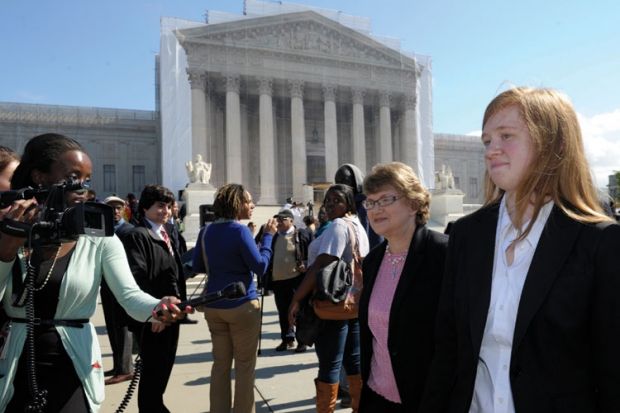When the US Supreme Court delivered its verdict on Fisher v University of Texas at Austin, many believed it would herald the beginning of the end for the use of race as a determining factor when admitting students to university.
Some states allow universities to implement so-called affirmative action policies, meaning institutions’ admissions policies are permitted to take ethnicity into account. The plaintiff in this case, Abigail Fisher, who is white, had claimed that she was unfairly denied admission to the university in 2008 because of such a policy (see box below).
The Supreme Court was accused by some of “fudging” its ruling, which it issued in June. It referred the case back to the Fifth Circuit Court of Appeals, claiming that when this more minor court had previously ruled in UT Austin’s favour, it had not applied sufficiently “strict scrutiny”.
The case will, as a result, continue its protracted passage through the courts, meaning that – for the time being at least – the University of Texas, and others, can continue to consider race in admissions for the small number of cases in which other considerations fail to determine whether or not a particular candidate should gain entry.
However, despite the reprieve for affirmative action, many believe that the writing is on the wall and are looking for alternative approaches that will help to ensure diversity within university student bodies without the need for positive discrimination.
“My personal opinion is that eventually we will see the end to affirmative action,” says Richard Cherwitz, professor in the departments of communication studies and rhetoric and writing at UT Austin. “Even most advocates of it recognise that. It should be used as a mechanism until it is no longer needed, but people will continue to debate when that point might be.”
In 1997, Cherwitz founded the Intellectual Entrepreneurship Consortium at the university, of which he is now director. Known as IE, the initiative comprises a diverse range of programmes and ideas bound together by an educational philosophy that encourages students of all ages to “discover, own and be accountable for their education”.
It was in the early days of this programme, originally offering courses designed to help graduate students with their professional development, that Cherwitz realised that it was reaching students from communities traditionally under-represented at universities – including those from black and minority ethnic backgrounds.
“After around 4,000 students had gone through our courses, we noticed that the demographics were interesting. At that point, about 9 per cent of University of Texas graduate students were under-represented minorities, compared to 25 per cent of IE participants,” he says.
After realising that the IE approach was having particular success in reaching under-represented groups, including those who were the first in their family to attend university, a number of other initiatives were launched.
The “It Could Be U” project offered intensive mentoring and “college readiness services” to secondary school pupils throughout Austin, with the aim of helping them to discover their passion, identify whether university would be a sensible route for them, and then plan a pathway that would allow them to get there.
“The idea was that each of the kids got a community liaison – a mentor in the community working in an industry they were interested in, like media,” Cherwitz explains. “Also, we at the university would give them an IE mentor. We wanted to see if this interaction would help them to find a pathway to college – particularly for those who might not normally look at higher education.”
Simply visiting high schools and telling students the advantages of going to university will not be sufficient to encourage those who are not considering university to change their minds, Cherwitz says.
“You can go into high schools in underserved communities and do a lot of recruitment, but at some point, if parents or teachers are just telling them they need to go to school, they’re not going to take it as seriously as if they discover it for themselves. That’s what we were trying to do with the It Could Be U project,” he adds.
Help them stay the course
According to the Lumina Foundation, which campaigns to increase the number of Americans who obtain a university degree, 38.7 per cent of working-age people in the US hold either a two- or four-year degree. Among whites, the figure is 43.3 per cent; for blacks, .1 per cent; and for Hispanics, 19.3 per cent.
Increasing admissions from under-represented communities is one way for universities to tackle this problem, while ensuring that those who enter higher education do not leave before obtaining a qualification is another.
According to US Department for Education data showing the number of students who gained a degree within six years of entering college in 2005, the graduation rate for black students was 37.9 per cent – 22 percentage points lower than the equivalent figure for whites.
Joseph Hotz, professor of economics at Duke University, co-authored a paper that compared undergraduate graduation rates for Hispanics, blacks and Native Americans in California both before and after the state prohibited the use of affirmative action in public education admissions in 1996.
While graduation rates among these minorities did increase after affirmative action was banned, overall enrolment rates in many colleges fell. The 2006 freshman year at the University of California, Los Angeles, for example, comprised little over 2 per cent African American students.
“There is a more general question about how we better improve graduation rates,” Hotz says. “University is a tremendously expensive investment, and it’s vital to make sure the right students are doing the right thing, in the sense that students who are capable of going on to higher education should be there, and for those who can’t we should be finding other things that they can do.”
Diverse approaches
To maintain diversity on its campuses after the ban, California tried a number of approaches, he says. “They set up counselling programmes for getting students better information about what [college is] like, and emphasising the importance of getting through the first year. It’s a different world, and a shock to the system – especially for minorities, who often haven’t been in this situation before.”
However, it is not yet possible to show how effective these programmes have been, he adds.
Cherwitz is encouraged by the potential for alternative outreach programmes to boost the number of minority students in US higher education, but he argues that affirmative action is still a necessary tool.
“I don’t know that IE could replace affirmative action, but its philosophy gives us hope for expanding the number of under-represented, first-generation, economically disadvantaged students who go to college,” he says.
“Whether we’re dealing with high school kids, middle school kids, graduates or undergraduates, by helping them to understand how to own and be accountable for their passion we do a lot of good things. One of those things is to increase diversity.”
Legal briefing: Fisher v University of Texas at Austin
In 1997, Texas introduced the “Top 10 per cent rule”, which guaranteed students who graduated from high school with results in the top 10 per cent of their school a place at a Texas state university, regardless of their race.
It was introduced to improve diversity on university campuses. Because the make-up of some high school student bodies is heavily skewed towards people of one race in particular, it was fairly successful.
In 2008, Abigail Fisher, who is white, did not graduate in the top 10 per cent of her high-school class, and so was not automatically guaranteed a place at the University of Texas at Austin.
She claimed that she had been unfairly denied admission because of the university’s use of affirmative action in admissions. Because the Top 10 per cent rule had increased diversity successfully, she argued, there was no longer a need for such positive discrimination.
The university argued that the rule did not increase diversity sufficiently, and so affirmative action was still required. It added that it would be impossible to prove that, even without affirmative action policies, Ms Fisher would have gained a place at UT Austin.
In June, the Supreme Court ruled neither in favour of nor against Ms Fisher, instead opting to refer the case back to a lower court for re‑evaluation.
Register to continue
Why register?
- Registration is free and only takes a moment
- Once registered, you can read 3 articles a month
- Sign up for our newsletter
Subscribe
Or subscribe for unlimited access to:
- Unlimited access to news, views, insights & reviews
- Digital editions
- Digital access to THE’s university and college rankings analysis
Already registered or a current subscriber? Login




